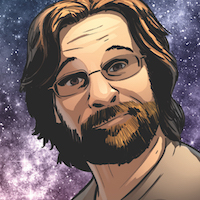Jupiter.
I want to talk about Jupiter today.
If you’ve met me, or attended any of the SPAAAAACE! And Why It’s Awesome! panels Garth and I have done at conventions this year, you know that I always want to talk about Jupiter. Even with Venus blazing beautifully at sunset right now, and with a seemingly endless stream of stunning photographs of Saturn, my attention is still focused primarily on the biggest, most dominant planet in the solar system. Jupiter.
Jupiter is the reason I’m into stargazing. A few years ago, after a marathon of Carl Sagan’s COSMOS, I picked up a copy of Astronomy Magazine on impulse. Inside were two memorable columns. One was discussing the best telescopes to buy if you want to get into astronomy; the other was all about weird and awesome facts about Jupiter. So I bought a recommended beginner’s telescope (the six inch dobsonian reflector that I use to this day) and trained it on Jupiter (after I figured out how to align the finder scope correctly).
I remember spending hours tracking Jupiter across the night sky. Even with urban light pollution, there was no hindering my view of this magnificent planet. I’d wrap myself up in layers of winter clothes, sometimes huddled over hot tea, just gazing and reflecting on it (no pun intended)… …that it’s the size of a thousand Earths. …that there are estimated to be over sixty moons in its orbit. …that the Red Spot is a centuries-old storm, three to four Earths wide. …that on Europa, one of the four Galilean moons, there may be the best chance for life in our solar system. …that it rains diamonds there. …that Jupiter may be a failed star (there’s strong evidence against this, but I still like the idea). …that its magnetic field is among the most dominant forces in our solar system, second only to the Sun. …that, in the mid-90s, it ripped up a comet that struck it so hard that the impacts caused explosions larger than Earth.
There are countless more strange and awesome facts about Jupiter and its moons, but I encourage you to discover them for yourself. You may end up tracking it through the night skies this year, like I did when I first aimed my first telescope to the stars.
